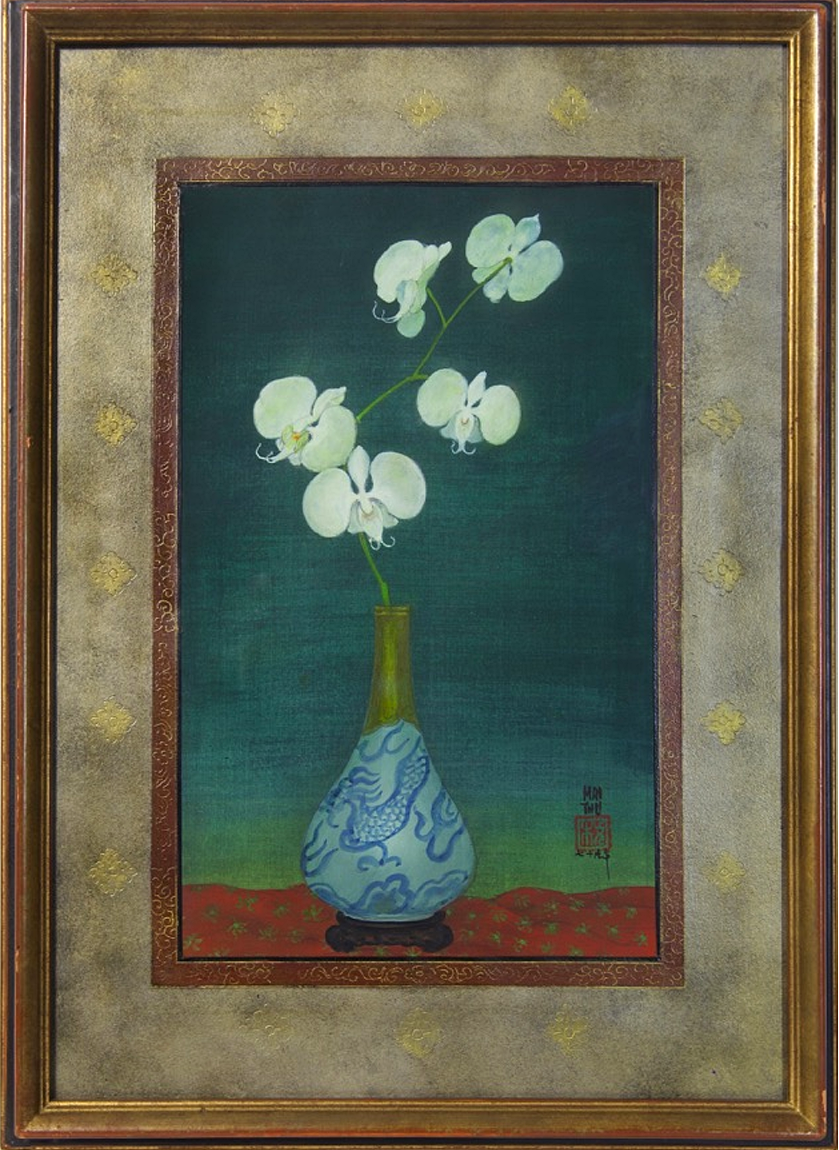
Mai Trung Thu (Vietnam/France, 1906-1980)
Orchid in Dragon Vase
signed 'MAI THU' and dated in Chinese '79' (lower right)
ink and gouache on silk laid on board in the artist's original frame
35.7 x 21.8 cm. (14 x 8 5/8 in.)
Painted in 1979
one seal of the artist
Price Realised HKD 475,000 at Christie's Hong Kong, 25 November 2018

The Delicate Manifestation
In 1960, the great French art critic Maximilien Gautier (1893-1977) was the first to analyse in great depth every element of Mai Thu's pictorial technique. It was clear to him that the artist was inspired by the six principles formulated by a sixth century Chinese portrait painter (himself inspired by a long lineage of predecessors). First, to seize the vital rhythm; second, a rendition of the essential structure of the line; third, necessity of resemblance; fourth, careful manipulation of colours and ink; fifth, special care for the composition and the role of space; sixth, benefit in copying the ancient to create new possibilities. Gautier added that, for him, Mai Thu's paintings were the "delicate manifestation" of these principles.
Any great painter - and Mai Thu is the epitome of this- knows how to capture the vital rhythm. We can imagine here the level of care needed for Mai Thu to search inspiration in the ancients and use them as models. We can also see the importance of resemblance expressed in a kind of assumed naivety. But these 4 points are more general principles that could characterize any artist of value, being oriental or western.
Two other points explain how Mai Thu made his name in the annals of art history: the rendition of the essential structure of the line and the careful manipulation of colours and ink. The characters are clearly fixed - almost imposed - on the silk by the use of the black ink (essentially for hair). Then, the application of gouache in limited colours, without mixture, clear aplats to finish the work. But this simplicity is only an appearance as the attentive eye can track the lighter touches, the subtle scratchings of gouache and can imagine the learned dosages the artist carefully used. Therefore, a work by Mai Thu needs to be admired closely for its finer details.
If the technique remains constant in time, the nine-works presented here - dated 1941 to 1979 - allow us to highlight two trends, among others: the painter "isolates" his models and simplifies its background.
Dated 1941, the poster named Annamite (Lot 308) and marked with a stamp is unique and atypical. It is worth mentioning that the old term "Annamite" used by the artist (Annamese) was never pejorative as some tried to propagate. Girl with Birdcage,1943 (Lot 301), Mother and Child, 1947 (Lot 302) and Mother and Child, 1946 (Lot 306) show generic models within non-ostentatious but distinguished interiors: beautiful but captive, elegant even in their affection, the women of Mai Thu are a testimony to the "Old World".
Then, gradually, as shown in the 1952 painting Woman By the Window (Lot 303) the exterior does not impose itself but proposes: the Vietnamese woman is not just a mother or a girl. She becomes emancipated and the enormous round windows symbolizes the call from the outside world.
Maternity (Lot 309), dated in 1955 shows us a mother 'outside the walls', showing a great tenderness for her child.
Lot 304, La Douleur (Pain), dated 1966 refocuses on this woman who seems contrite by the return of war in Vietnam (indeed, Mai Thu was very saddened by this).
Lot 307, Jeune Femme Endormie (Young Lady Sleeping), dated 1967 is a manifestation of sweetness and will to learn.
Lot 305, Orchid in Dragon Vase, dated 1979, is an extremely rare subject painted the final year of the artist's life, the last allegory in the quest for the essence of things. As for the previous three works the background becomes secondary, it is no longer a decor but a way of highlighting the main object.
To strengthen this re-centring the painter makes his own frames in the 1950's, to enhance the pictorial work.
Jean-François Hubert
Senior Expert, Vietnamese Art










